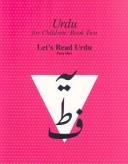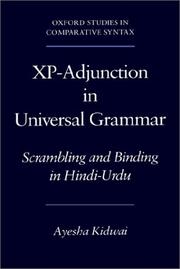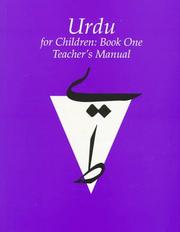| Listing 1 - 10 of 12 | << page >> |
Sort by
|
Book
ISBN: 0773594159 9780773594159 9780773542150 Year: 1967 Publisher: Montreal, Québec : Montreal, Quebec : Institute of Islamic Studies, McGill University, McGill University Press,
Abstract | Keywords | Export | Availability | Bookmark
 Loading...
Loading...Choose an application
- Reference Manager
- EndNote
- RefWorks (Direct export to RefWorks)
Urdu language --- Bihari language (Urdu) --- Gujri language --- Gurjari language --- Islami language --- Moorish language (India) --- Undri language --- Urudu language --- Hindustani language


ISBN: 1283530104 9786613842558 0773580530 9780773580534 0773527605 9780773527607 9781283530101 6613842559 Year: 2004 Publisher: Montreal : ©2004 McGill-Queen's University Press,
Abstract | Keywords | Export | Availability | Bookmark
 Loading...
Loading...Choose an application
- Reference Manager
- EndNote
- RefWorks (Direct export to RefWorks)
While similar in method to the "activity-based learning" introduced in the first set of books, Urdu for Children: Book II is designed to meet the needs of children seven to eight years of age and older. The students' level is determined by their facility in reading, writing, and speaking Urdu rather than their chronological age. The scope of the topics in Book II is wider than in Book I and the forty stories and poems, most of them original, are more complex and longer. The original artwork is richer and more varied and the English-Urdu and Urdu-English vocabulary lists are more comprehensive. Two volumes of Let's Read Urdu have been added to help children enhance their reading skills while a two-part Workbook provides practice exercises in writing and reinforces the new vocabulary introduced in the texts. The activity-based Teacher's Manual provides detailed lesson plans for each Urdu text. Two CDs accompanying the two volumes of the textbook to help ensure standard pronunciation of words and intonations in sentences, and infuse life into the stories. Original music was composed for the poems, allowing children to sing them to help with memorization. Developed by a team of trained public school teachers with extensive backgrounds in teaching Urdu as a heritage language, the Urdu Language Textbook Series helps meet the needs of a rapidly growing Urdu-speaking community in North America. It is the first step towards helping children develop Urdu linguistic skills so that they can keep their heritage and culture alive.
Urdu language --- Bihari language (Urdu) --- Gujri language --- Gurjari language --- Islami language --- Moorish language (India) --- Undri language --- Urudu language --- Hindustani language --- Study and teaching
Book
ISBN: 1463206135 1463237340 9781463206130 9781463237349 Year: 2016 Publisher: Piscataway, NJ
Abstract | Keywords | Export | Availability | Bookmark
 Loading...
Loading...Choose an application
- Reference Manager
- EndNote
- RefWorks (Direct export to RefWorks)
This is the first-ever study of Judeo-Urdu, that is, the Hindi/Urdu language written in Hebrew script. It provides background and an introduction to the Judeo-Urdu corpus, presents nearly two hundred entries from one text — a Hebrew-Judeo-Urdu glossary — and analyzes the orthography, phonology, and morphology of Judeo-Urdu. Comparison is made to standard Hindi and Urdu, from which Judeo-Urdu diverges in many interesting ways.
Urdu language --- Dialects --- Bihari language (Urdu) --- Gujri language --- Gurjari language --- Islami language --- Moorish language (India) --- Undri language --- Urudu language --- Hindustani language

ISBN: 1280965673 9786610965670 0198030398 0195351053 9780198030393 9780195351057 0195132513 0195132521 9780195132519 9780195132526 9781280965678 6610965676 0197722822 Year: 2023 Publisher: New York ; Oxford University Press,
Abstract | Keywords | Export | Availability | Bookmark
 Loading...
Loading...Choose an application
- Reference Manager
- EndNote
- RefWorks (Direct export to RefWorks)
This text investigates the properties of Hindi-Urdu scrambling to show that it must be analyzed as uniformly a focality-driven XP-adjunction operation. It will be of interest to both students and specialists in Hindi/Urdu syntax.
Grammar, Comparative and general --- Hindi language --- Urdu language --- Bihari language (Urdu) --- Gujri language --- Gurjari language --- Islami language --- Moorish language (India) --- Undri language --- Urudu language --- Hindustani language --- Language and languages --- Syntax --- Syntax. --- Linguistics --- Philology --- Grammar, Comparative and general Syntax --- Grammar, Generative.


ISBN: 1283530112 9786613842565 0773580549 9780773580541 0773516220 9780773516229 0773516204 9780773516205 9786613851505 0773580557 1283539055 Year: 1997 Publisher: Montreal : ©1997 McGill-Queen's University Press,
Abstract | Keywords | Export | Availability | Bookmark
 Loading...
Loading...Choose an application
- Reference Manager
- EndNote
- RefWorks (Direct export to RefWorks)
Urdu for Children is the first comprehensive instructional package for teaching children Urdu as a second language. It includes a two-volume textbook, a workbook for learning the mechanics of Urdu writing, a comprehensive teacher's manual, and an audio cassette. Aimed at North American children between the ages of four and six, Urdu for Children combines traditional and whole-language instructional methods. The two-volume textbook includes forty lessons, each structured around a story or poem that reflects the theme "All About Me." This theme was chosen because children in the primary division show the greatest enthusiasm for things that relate to themselves. The methodology, outlined in the teacher's manual, was specifically designed to promote the integration of listening, speaking, reading, and writing skills; the children listen to the story or poem recorded on the audio cassette or read by the teacher, repeat it in unison, and read it from the chart. Flash cards, role-playing, and drawing are also used to reinforce vocabulary and comprehension. Developed by a team of trained school teachers with extensive backgrounds in teaching Urdu as a heritage language, Urdu for Children will help meet the needs of a rapidly growing Urdu-speaking community in North America.
Urdu language --- Bihari language (Urdu) --- Gujri language --- Gurjari language --- Islami language --- Moorish language (India) --- Undri language --- Urudu language --- Hindustani language --- Study and teaching (Primary) --- Children's literature, Urdu. --- English. --- Urdu children's literature --- Urdu literature
Book
ISBN: 1443896632 9781443896634 9781443871624 1443871621 Year: 2016 Publisher: Newcastle upon Tyne, England : Cambridge Scholars Publishing,
Abstract | Keywords | Export | Availability | Bookmark
 Loading...
Loading...Choose an application
- Reference Manager
- EndNote
- RefWorks (Direct export to RefWorks)
Urdu language --- Bihari language (Urdu) --- Gujri language --- Gurjari language --- Islami language --- Moorish language (India) --- Undri language --- Urudu language --- Hindustani language --- Foreign words and phrases --- Arabic. --- Persian. --- Persian language --- Arabic language
Book
ISBN: 9789004177314 9004177310 9789004182233 9004182233 1282786385 9786612786389 Year: 2010 Publisher: Leiden, NL Brill
Abstract | Keywords | Export | Availability | Bookmark
 Loading...
Loading...Choose an application
- Reference Manager
- EndNote
- RefWorks (Direct export to RefWorks)
This book sheds light on the complex relationship between Hindi and Urdu. Through a detailed reading of a representative set of 20th century short stories in both languages, the author leads the reader towards a clear definition of the differences between Hindi and Urdu. The full translations of the stories have been extensively annotated to point out the details in which the Hindi and Urdu versions differ. An overview of early and contemporary Hindi/Urdu and Hindustani grammars and language teaching textbooks demonstrates the problems of correctly naming and identifying the two languages. This book now offers a detailed and systematic database of syntactic, morphological and semantic differences between the selected Hindi and Urdu stories. A useful tool for all scholars of modern Hindi/Urdu fiction, (socio-)linguistics, history or social sciences.
Short stories, Hindi --- Short stories, Urdu --- Hindi language. --- Urdu language. --- Comparative literature --- Translating and interpreting. --- History and criticism. --- Hindi and Urdu. --- Urdu and Hindi. --- Interpretation and translation --- Interpreting and translating --- Language and languages --- Literature --- Translation and interpretation --- Translators --- Literature, Comparative --- Philology --- Bihari language (Urdu) --- Gujri language --- Gurjari language --- Islami language --- Moorish language (India) --- Undri language --- Urudu language --- Hindustani language --- Translating --- History and criticism
Book
ISBN: 9780262357319 0262357313 9780262043618 9780262538275 026253827X 0262043610 0262357321 Year: 2020 Publisher: Cambridge, Massachusetts MIT Press
Abstract | Keywords | Export | Availability | Bookmark
 Loading...
Loading...Choose an application
- Reference Manager
- EndNote
- RefWorks (Direct export to RefWorks)
"This monograph is the first book-length investigation of 'selective opacity'--configurations in which syntactic domains are opaque to some processes, but transparent to others--, and it develops a comprehensive theory of such configurations within a contemporary Minimalist framework. While such configurations have traditionally been analyzed in terms of restrictions on possible sequences of movement steps, the monograph shows that analogous restrictions govern long-distance dependencies that do not involve movement, and it proposes that the phenomenon is more widespread and abstract than previously assumed. The monograph develops a new approach to such effects, according to which probes are subject to characteristic 'horizons', which terminate their search. This analysis furthermore has important implications for key concepts of locality like the distribution of phases. The subject of the monograph falls within the fundamental domain of the locality of syntactic dependencies, with a specific focus on in-depth case studies of Hindi-Urdu and German. It contains detailed investigations of movement dependencies, long-distance agreement, wh-dependencies, the A/A'-distinction, restructuring, freezing effects, successive cyclicity, and phase theory. The intent of the monograph is to develop a comprehensive theory of selective-opacity effects within a Minimalist framework. As such, the monograph will be of interest to all linguists working on theoretical syntax in general and syntactic locality in particular. Furthermore, the in-depth case studies of Hindi-Urdu and German make it highly relevant to linguists interested in theoretical and/or empirical work on Indo-Aryan languages or Germanic"--
Grammar, Comparative and general --- Hindi language --- Urdu language --- German language --- Subordinate constructions --- Syntax --- Bihari language (Urdu) --- Gujri language --- Gurjari language --- Islami language --- Moorish language (India) --- Undri language --- Urudu language --- Hindustani language --- Language and languages --- Subordination (Linguistics) --- Subordinate constructions. --- Syntax. --- Linguistics --- Philology --- Grammar, Comparative and general Syntax
Book
ISBN: 1283174936 9786613174932 902728699X 9789027286994 9781283174930 9789027208217 9027208212 Year: 2011 Publisher: Amsterdam Philadelphia John Benjamins
Abstract | Keywords | Export | Availability | Bookmark
 Loading...
Loading...Choose an application
- Reference Manager
- EndNote
- RefWorks (Direct export to RefWorks)
This research monograph is an investigation of wh-movement and wh-expletive constructions in the Indic languages Kashmiri and Hindi-Urdu. It advances a novel theory of the periphery, or the clausal positions that mediate A-bar movement. In particular, a detailed study of wh-expletives and wh-expletive constructions reveals an underlying similarity of design between the A and A-bar systems, and indicates that the two can be understood as driven by the same basic set of mechanisms. The monograph offers an account of wh-movement and the clausal periphery in the two languages, informed by the latest strands of research on the syntax and semantics of A-bar movement. This micro-comparative analytical method yields an important result: we can understand a set of systematic contrasts between the two languages in terms of the properties of specifically the phase-defining heads C and v. Empirically, this work explores the lesser-studied language Kashmiri, bringing to the fore linguistic data not yet discussed in formal syntactic literature. The significance of these data for the development of the wider theoretical framework is stressed throughout, making the book of substantial interest for general linguistic research.
Grammar, Comparative and general --- Kashmiri language --- Hindi language --- Urdu language --- Bihari language (Urdu) --- Gujri language --- Gurjari language --- Islami language --- Moorish language (India) --- Undri language --- Urudu language --- Hindustani language --- Cashmeeree language --- Cashmiri language --- Kacmiri language --- Kaschemiri language --- Kāšur language --- Keshur language --- Dardic languages --- Language and languages --- Syntax --- Syntax. --- Linguistics --- Philology --- Grammar, Comparative and general Syntax
Book
ISBN: 0199092117 0199091722 Year: 2019 Publisher: New Delhi : Oxford University Press,
Abstract | Keywords | Export | Availability | Bookmark
 Loading...
Loading...Choose an application
- Reference Manager
- EndNote
- RefWorks (Direct export to RefWorks)
Moving beyond the existing scholarship on language politics in north India which implicitly or explicitly focuses on Hindi-Urdu debates, this text examines the formation of the Maithili movement in the context of expansion of Hindi as the 'national' language.
Language policy --- Sociolinguistics --- Maithili language --- Hindi language --- Urdu language --- Political aspects --- India, North --- Languages --- Political aspects. --- Bihari language (Urdu) --- Gujri language --- Gurjari language --- Islami language --- Moorish language (India) --- Undri language --- Urudu language --- Hindustani language --- Apabhramsa language (Maithili) --- Bihari language (Maithili) --- Maitili language --- Maitli language --- Methli language --- Tirahutia language --- Tirhuti language --- Tirhutia language --- Bihari languages --- India, Northern --- North India --- Northern India --- Uttar Bhārat --- Uttara Bhārata --- Language and culture --- Linguistics --- Sociology --- Integrational linguistics (Oxford school) --- Communication policy --- Language planning
| Listing 1 - 10 of 12 | << page >> |
Sort by
|

 Search
Search Feedback
Feedback About UniCat
About UniCat  Help
Help News
News